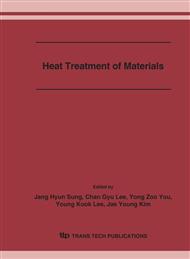p.71
p.77
p.85
p.91
p.97
p.103
p.109
p.115
p.121
Efficiency Improvement of Vacuum Carburizing by Using Natural Gas
Abstract:
Acetylene and ethylene are frequently used in vacuum carburizing in Japan. In this study the natural gas which is available from the lifeline is applied to vacuum carburizing. The gas composition inside the furnace was analyzed by the gas chromatography in order to examine the carbon infiltration mechanism. Unsaturated hydrocarbon gases (such as acetylene and ethylene) are generated from the natural gas. The effect of acetylene concentration in the furnace on the carbon infiltration rate was investigated. The carbon amount which infiltrates into the steel increases, as acetylene concentration in furnace increases. It is possible that carbon concentration of specimen surface increases to the cementite precipitation concentration in the short term, when natural gas flow rate increases in the initial carburizing stage. After that, carbon concentration of specimen surface does not decrease, even if the natural gas flow decreases, because carbon atoms which are consumed for diffusion to inside are sufficiently supplied. By using this method, inhibition of soot generation, reduction of process gas and shortening of the carburizing period are possible. The carbon concentration profile of the vacuum carburized specimen was compared with the simulation.
Info:
Periodical:
Pages:
97-102
Citation:
Online since:
December 2006
Price:
Сopyright:
© 2006 Trans Tech Publications Ltd. All Rights Reserved
Share:
Citation:


